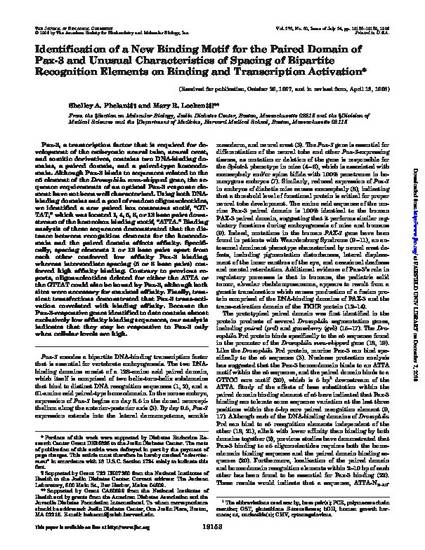
- Biology and
- Life Sciences
Pax-3, a transcription factor that is required for development of the embryonic neural tube, neural crest, and somitic derivatives, contains two DNA-binding domains, a paired domain, and a paired-type homeodomain. Although Pax-3 binds to sequences related to the e5 element of the Drosophila even-skipped gene, the sequence requirements of an optimal Pax-3 response element have not been well characterized. Using both DNA-binding domains and a pool of random oligonucleotides, we identified a new paired box consensus motif, “GTTAT,” which was located 1, 4, 5, 8, or 13 base pairs downstream of the homeobox binding motif, “ATTA.” Binding analysis of these sequences demonstrated that the distance between recognition elements for the homeodomain and the paired domain affects affinity. Specifically, spacing elements 1 or 13 base pairs apart from each other conferred low affinity Pax-3 binding, whereas intermediate spacing (5 or 8 base pairs) conferred high affinity binding. Contrary to previous reports, oligonucleotides deleted for either the ATTA or the GTTAT could also be bound by Pax-3, although both sites were necessary for maximal affinity. Finally, transient transfections demonstrated that Pax-3 trans-activation correlated with binding affinity. Because the Pax-3-responsive genes identified to date contain almost exclusively low affinity binding sequences, our analysis indicates that they may be responsive to Pax-3 only when cellular levels are high.
Available at: http://works.bepress.com/shelley_phelan/12/

Copyright 1998 The American Society for Biochemistry and Molecular Biology, Inc.
This research was originally published in the Journal of Biological Chemistry. Phelan, S. A., & Loeken, M. R. (1998). Identification of a new binding motif for the paired domain of Pax-3 and unusual characteristics of spacing of bipartite recognition elements on binding and transcription activation. Journal of Biological Chemistry, 273(30), 19153-19159. © the American Society for Biochemistry and Molecular Biology.
The final publisher PDF has been archived here with permission from the copyright holder.